Neurostimulation Devices Market Size
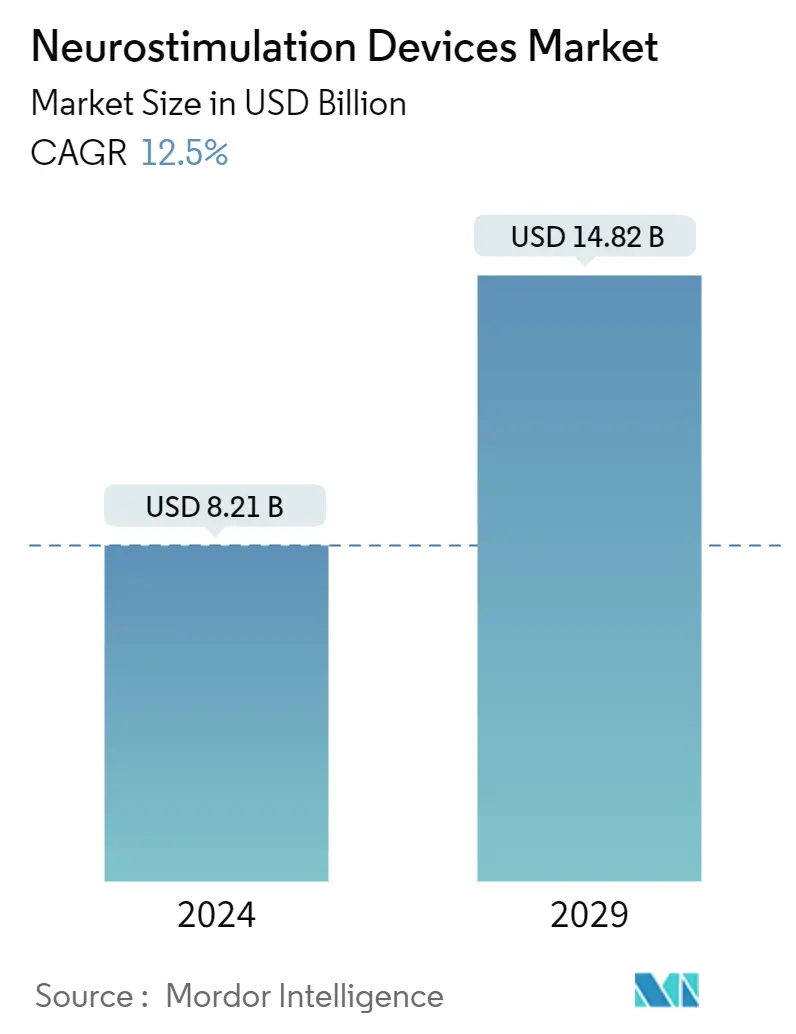
| Study Period | 2019 - 2029 |
| Market Size (2024) | USD 8.21 Billion |
| Market Size (2029) | USD 14.82 Billion |
| CAGR (2024 - 2029) | 12.50 % |
| Fastest Growing Market | Asia-Pacific |
| Largest Market | North America |
Major Players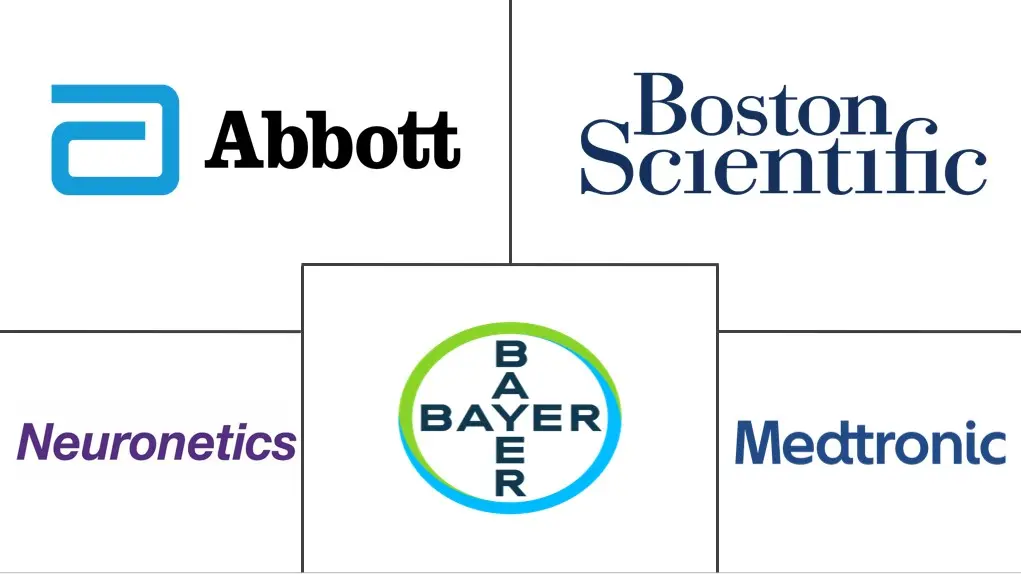
*Disclaimer: Major Players sorted in no particular order |
Neurostimulation Devices Market Analysis
The Neurostimulation Devices Market size is estimated at USD 8.21 billion in 2024, and is expected to reach USD 14.82 billion by 2029, growing at a CAGR of 12.5% during the forecast period (2024-2029).
Factors such as the rising prevalence of neurological disorders and the technological advancements in neurostimulation devices are expected to bolster market growth over the forecast period. For instance, according to the September 2022 report of the World Health Organization, about 55 million people around the world had dementia, and nearly 10 million cases were reported annually. Thus, with the rise in the prevalence of neurological diseases, the demand for neurostimulation devices is expected to increase, which is anticipated to impact the growth of the market. Furthermore, according to the Primary Care Dementia Data, published in January 2023 by NHS, 7,355 males and 6,693 females aged 65 and above were reported to have dementia in England in January 2023. Thus, owing to the high incidence of neurological diseases, the demand for neurostimulation devices is expected to rise, fuelling market growth over the forecast period.
An increase in strategic activities by the key players, such as product launches and collaborations, and a surge in product approvals by regulatory authorities bolsters market growth. For instance, in January 2022, TensCare showcased its latest in transcutaneous electrical nerve stimulation widely used for drug-free pain relief in the long-term treatment of chronic pain conditions such as diabetic neuropathy, backache, sciatica, osteoarthritis and the relief of the acute pain of childbirth at Arab Health 2022.
Similarly, in November 2022, ElectroCore Inc., a commercial-stage bioelectronic medicine company, received a Unique National Product Code Number from the Belgian Pharmaceutical Association for its gammaCore Sapphire non-invasive vagus nerve stimulator (nVNS). Further, in August 2022, Medtronic Private Limited launched the SenSight directional lead system for Deep Brain Stimulation (DBS) therapy to treat symptoms associated with movement disorders and epilepsy in India. Deep brain stimulation (DBS) is a treatment for symptoms of Parkinson's disease, including tremors, stiffness, and trouble walking.
Thus, owing to the increase in neurological diseases and strategic activities by the key players, the market is expected to witness significant growth over the forecast period. However, factors such as the complications associated with neurostimulation devices and stringent device approval regulations are expected to restrain the market growth during the forecast period.
Neurostimulation Devices Market Trends
Spinal Cord Stimulators are Expected to Dominate the Market During the Forecast Period
The spinal cord stimulators segment is expected to witness significant growth over the forecast period owing to factors such as the increasing prevalence of neurological disorders and other issues, such as depression and chronic pain, and the increasing adoption of technologically advanced products. For instance, as per the National Spinal Cord Injury Statistical Center (NSCISC), the incidence of SCI in the United States was about 334 million in 2022. Also, the annual incidence of traumatic spinal cord injury (tSCI) was approximately 54 cases per one million people in the United States, or about 18,000 new tSCI cases yearly. Hence, the demand for spinal cord stimulators is increasing with the increase in spinal cord injuries.
The increase in spinal cord stimulator launches, regulatory approvals, and advancements in the device are expected to bolster the market growth over the forecast period. For instance, in December 2022, Abbott received FDA approval for the company's Eterna spinal cord stimulation (SCS) system, the smallest implantable, rechargeable spinal cord stimulator available for treating chronic pain. Introducing multiphase spinal cord stimulators to the market is expected to fuel the segment's growth. For instance, in April 2023, Biotronik received FDA approval for Prospera, a spinal cord stimulation (SCS) system. The system features RESONANCE, the first multiphase stimulation paradigm, paired with Embrace One. This patient-centric model makes proactive care possible by offering automatic, objective, daily remote monitoring and ongoing management and support.
In September 2022, Taiwanese medical device manufacturer GIMER Medical received conditional Investigational Device Exemption (IDE) approval from the FDA for the company's spinal cord stimulation system. The implantable device aims to relieve patients' chronic pain with its patented technology. GIMER Medical's NeuroBlock SCS system offers effective pain management by releasing a novel high-frequency stimulation of 500 kHz to the spinal cord.
Therefore, due to the increase in spinal cord injuries and the surge in regulatory approvals and strategic product launches by key players, the segment is expected to grow over the forecast period.
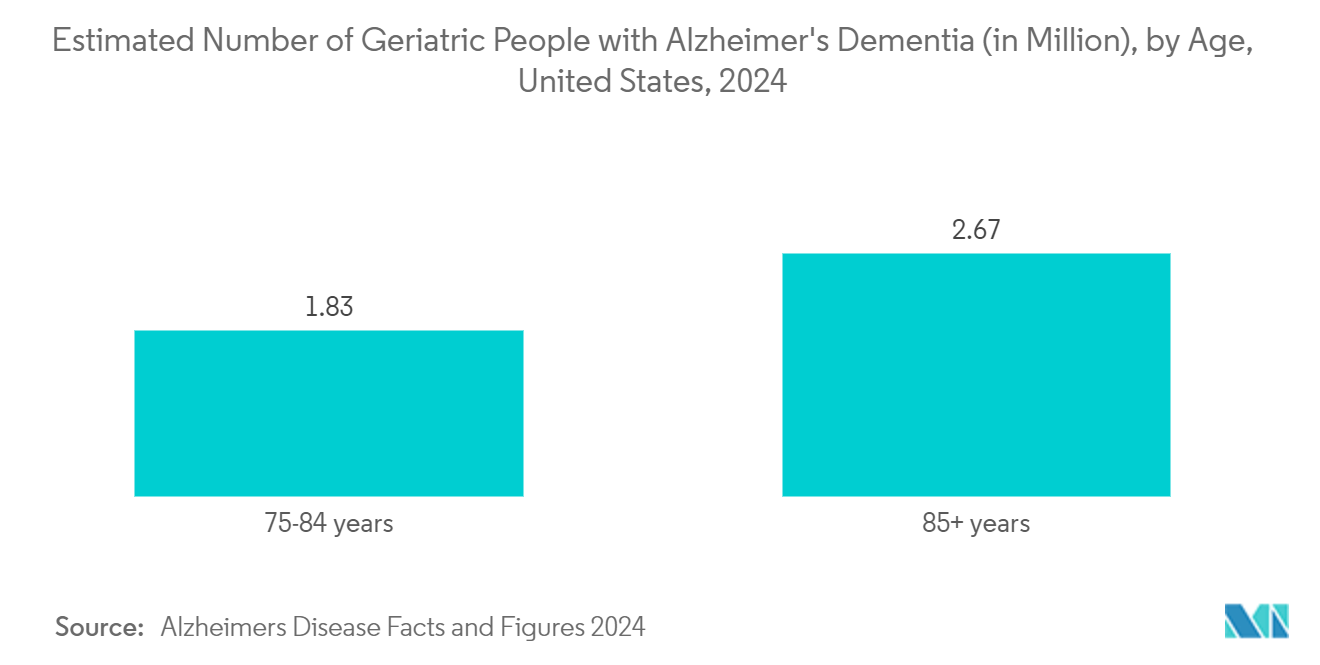
North America is Expected to Witness Significant Growth Over the Forecast Period
North America is expected to witness healthy growth in the neurostimulation devices market owing to the rising geriatric population, increasing neurological disorders, and strategic product launches by the key players. For instance, as per the 2022 update from the Parkinson's Foundation, nearly one million people in the United States had Parkinson's disease (PD). This number is expected to rise to 1.2 million by 2030. Parkinson's is the second-most common neurodegenerative disease after Alzheimer's disease. Hence, the high prevalence of neurological diseases will likely boost the market growth in North America.
The presence of key players and strategic product launches, partnerships, device approvals, and collaborations are expected to bolster market growth over the forecast period. For instance, in December 2023, Medtronic's Percept RC neurostimulator for deep brain stimulation (DBS) was granted the prestigious CE (Conformité Européenne) Mark. This cutting-edge device, touted as the most compact and slender in its class 1-4, not only stands out for its size but also for being the sole rechargeable DBS system featuring the innovative BrainSense sensing technology.
In January 2022, Nevro Corp received approval from the FDA for expanded labeling for its Senza Spinal Cord Stimulation (SCS) System for treating Non-Surgical Refractory Back Pain (NSRBP). Also, in January 2022, Medtronic received FDA approval for its Intellis rechargeable neurostimulator and Vanta recharge-free neurostimulator for treating chronic pain associated with diabetic peripheral neuropathy (DPN).
Thus, the increasing cases of neurological disorders and increasing company activities in the region are expected to augment market growth over the forecast period.
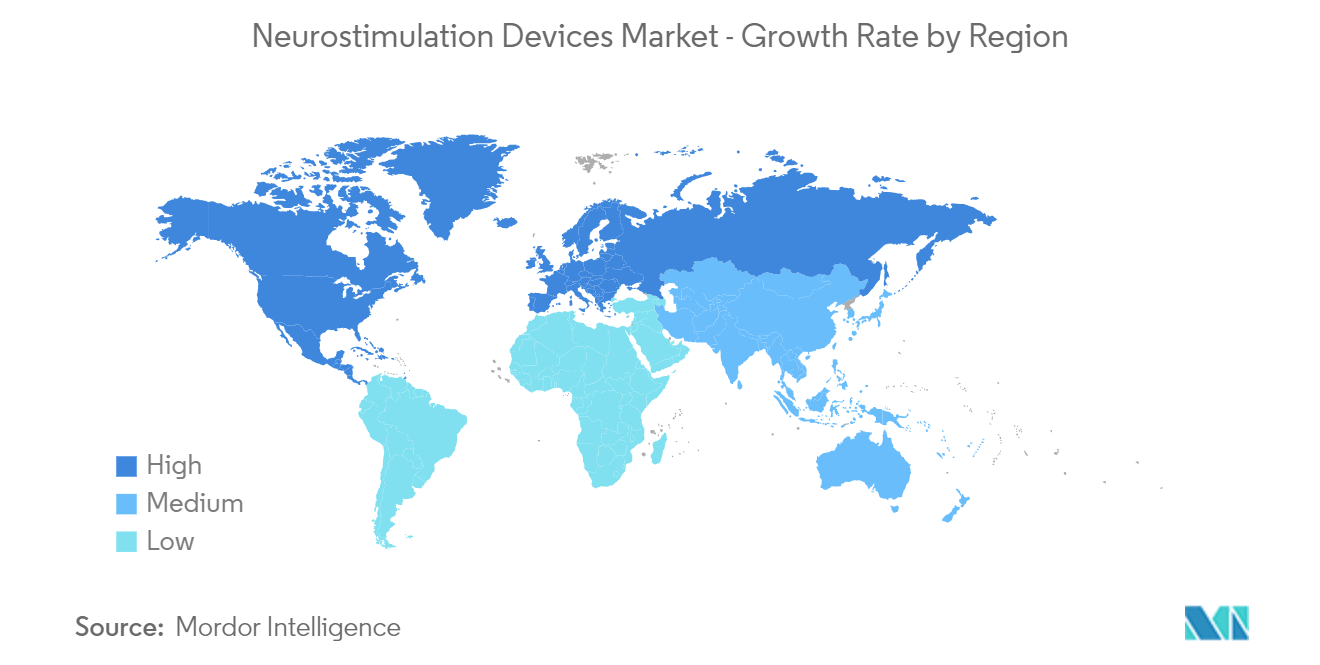
Neurostimulation Devices Industry Overview
The neurostimulation devices market is fragmented in nature due to the presence of several companies operating globally. The key players adopt various strategies to maintain their market positions, such as acquisitions, partnerships, and heavy investments in research and development activities and new product launches. The major players include Abbott, Bayer AG, Boston Scientific Corporation, Laborie, LivaNova PLC, Neuronetics, NeuroPace Inc., Nevro Corp., Medtronic, and Synapse Biomedical Inc.
Neurostimulation Devices Market Leaders
-
Boston Scientific Corporation
-
Abbott
-
Neuronetics
-
Medtronic
-
Bayer AG
*Disclaimer: Major Players sorted in no particular order
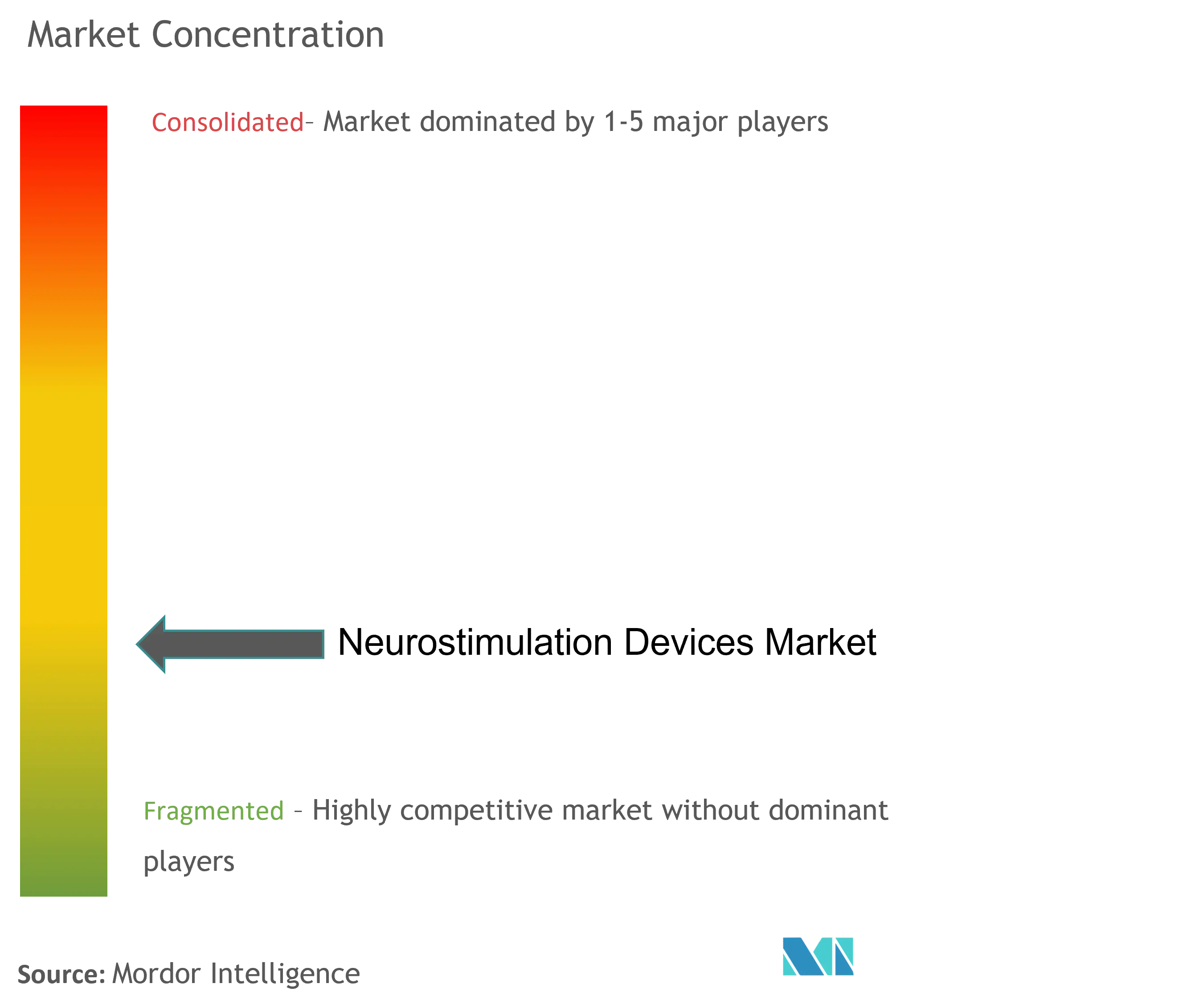
Neurostimulation Devices Market News
- May 2023: Abbott received FDA approval for its spinal cord stimulation (SCS) systems for treating chronic back pain in people who have not had or are not eligible to receive back surgery, known as non-surgical back pain. This new indication applies to all Abbott's SCS products in the United States, including the Eterna SCS platform and the Proclaim SCS family.
- January 2023: Axonics Inc., a global medical technology company, received the US Food and Drug Administration approval for the company's fourth-generation rechargeable sacral neuromodulation system.
Neurostimulation Devices Market Report - Table of Contents
1. INTRODUCTION
- 1.1 Study Assumptions and Market Definition
- 1.2 Scope of the Study
2. RESEARCH METHODOLOGY
3. EXECUTIVE SUMMARY
4. MARKET DYNAMICS
- 4.1 Market Overview
-
4.2 Market Drivers
- 4.2.1 Rise in Prevalence of Neurological Disorders
- 4.2.2 Technological Advancements in Neurostimulation Devices
-
4.3 Market Restraints
- 4.3.1 Complications Associated with Neurostimulation Devices
- 4.3.2 Stringent Device Approval Regulations
-
4.4 Porter's Five Forces Analysis
- 4.4.1 Bargaining Power of Buyers/Consumers
- 4.4.2 Bargaining Power of Suppliers
- 4.4.3 Threat of New Entrants
- 4.4.4 Threat of Substitute Products
- 4.4.5 Intensity of Competitive Rivalry
5. MARKET SEGMENTATION (Market Size by Value - USD)
-
5.1 By Device Type
- 5.1.1 Implantable Devices
- 5.1.1.1 Spinal Cord Stimulators
- 5.1.1.2 Deep Brain Stimulators
- 5.1.1.3 Sacral Nerve Stimulators
- 5.1.1.4 Vagus Nerve Stimulators
- 5.1.1.5 Gastric Electric Stimulators
- 5.1.1.6 Other Device Types
- 5.1.2 External Devices
- 5.1.2.1 Transcranial Magnetic Stimulation (TMS)
- 5.1.2.2 Transcutaneous Electrical Nerve Stimulation (TENS)
- 5.1.2.3 Other External Devices
-
5.2 By Application
- 5.2.1 Parkinson's Disease
- 5.2.2 Epilepsy
- 5.2.3 Depression
- 5.2.4 Dystonia
- 5.2.5 Pain Management
- 5.2.6 Other Applications
-
5.3 By End-Users
- 5.3.1 Clinics
- 5.3.2 Hospitals
- 5.3.3 Rehabilitation Centers
-
5.4 Geography
- 5.4.1 North America
- 5.4.1.1 United States
- 5.4.1.2 Canada
- 5.4.1.3 Mexico
- 5.4.2 Europe
- 5.4.2.1 Germany
- 5.4.2.2 United Kingdom
- 5.4.2.3 France
- 5.4.2.4 Italy
- 5.4.2.5 Spain
- 5.4.2.6 Rest of Europe
- 5.4.3 Asia-Pacific
- 5.4.3.1 China
- 5.4.3.2 Japan
- 5.4.3.3 India
- 5.4.3.4 Australia
- 5.4.3.5 South Korea
- 5.4.3.6 Rest of Asia-Pacific
- 5.4.4 Middle East and Africa
- 5.4.4.1 GCC
- 5.4.4.2 South Africa
- 5.4.4.3 Rest of Middle East and Africa
- 5.4.5 South America
- 5.4.5.1 Brazil
- 5.4.5.2 Argentina
- 5.4.5.3 Rest of South America
6. COMPETITIVE LANDSCAPE
-
6.1 Company Profiles
- 6.1.1 Abbott
- 6.1.2 Curonix LLC
- 6.1.3 Boston Scientific Corporation
- 6.1.4 Aleva Neurotherapeutics
- 6.1.5 LivaNova PLC
- 6.1.6 Neuronetics
- 6.1.7 NeuroPace Inc.
- 6.1.8 Nevro Corp
- 6.1.9 Medtronic
- 6.1.10 Synapse Biomedical Inc.
- *List Not Exhaustive
7. MARKET OPPORTUNITIES AND FUTURE TRENDS
** Subject To AvailablityNeurostimulation Devices Industry Segmentation
As per the report's scope, neurostimulation is the electrical process of inhibition, stimulation, modification, regulation, or therapeutic alteration of activity in the central, peripheral, or autonomic nervous systems. The device that generates the electrical impulses are considered neurostimulation devices.
The neurostimulation devices market is segmented by device type, application, end user, and geography. By device type, the market is segmented into implantable devices and external devices. By application, the market is segmented into Parkinson's disease, epilepsy, depression, dystonia, pain management, and others. By end user, the market is segmented into clinics, hospitals, and rehabilitation centers. By geography, the market is segmented into North America, Europe, Asia-Pacific, the Middle East and Africa, and South America. The report also covers the estimated market sizes and trends for 17 countries across major regions globally. The report offers the value (USD) for all the above segments.
| By Device Type | Implantable Devices | Spinal Cord Stimulators |
| Deep Brain Stimulators | ||
| Sacral Nerve Stimulators | ||
| Vagus Nerve Stimulators | ||
| Gastric Electric Stimulators | ||
| Other Device Types | ||
| By Device Type | External Devices | Transcranial Magnetic Stimulation (TMS) |
| Transcutaneous Electrical Nerve Stimulation (TENS) | ||
| Other External Devices | ||
| By Application | Parkinson's Disease | |
| Epilepsy | ||
| Depression | ||
| Dystonia | ||
| Pain Management | ||
| Other Applications | ||
| By End-Users | Clinics | |
| Hospitals | ||
| Rehabilitation Centers | ||
| Geography | North America | United States |
| Canada | ||
| Mexico | ||
| Geography | Europe | Germany |
| United Kingdom | ||
| France | ||
| Italy | ||
| Spain | ||
| Rest of Europe | ||
| Geography | Asia-Pacific | China |
| Japan | ||
| India | ||
| Australia | ||
| South Korea | ||
| Rest of Asia-Pacific | ||
| Geography | Middle East and Africa | GCC |
| South Africa | ||
| Rest of Middle East and Africa | ||
| Geography | South America | Brazil |
| Argentina | ||
| Rest of South America |
Neurostimulation Devices Market Research FAQs
How big is the Neurostimulation Devices Market?
The Neurostimulation Devices Market size is expected to reach USD 8.21 billion in 2024 and grow at a CAGR of 12.5% to reach USD 14.82 billion by 2029.
What is the current Neurostimulation Devices Market size?
In 2024, the Neurostimulation Devices Market size is expected to reach USD 8.21 billion.
Who are the key players in Neurostimulation Devices Market?
Boston Scientific Corporation, Abbott, Neuronetics, Medtronic and Bayer AG are the major companies operating in the Neurostimulation Devices Market.
Which is the fastest growing region in Neurostimulation Devices Market?
Asia-Pacific is estimated to grow at the highest CAGR over the forecast period (2024-2029).
Which region has the biggest share in Neurostimulation Devices Market?
In 2024, the North America accounts for the largest market share in Neurostimulation Devices Market.
What years does this Neurostimulation Devices Market cover, and what was the market size in 2023?
In 2023, the Neurostimulation Devices Market size was estimated at USD 7.18 billion. The report covers the Neurostimulation Devices Market historical market size for years: 2019, 2020, 2021, 2022 and 2023. The report also forecasts the Neurostimulation Devices Market size for years: 2024, 2025, 2026, 2027, 2028 and 2029.
Neurostimulation Devices Industry Report
Statistics for the 2024 Neurostimulation Devices market share, size and revenue growth rate, created by Mordor Intelligence™ Industry Reports. Neurostimulation Devices analysis includes a market forecast outlook to 2029 and historical overview. Get a sample of this industry analysis as a free report PDF download.



